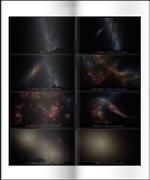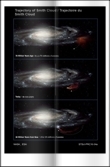
| CONTENT - A tutorial about how our Milky Way Galaxy is indeed bound to a merger with the Andromeda Galaxy like Hubble research found in 2012 |
As collision and mergers are common in the world of galaxies, astronomers held during a century for a speculative view that our Milky Way Galaxy was bound to such a collision with the Andromeda Galaxy, or M31 located by 2.5 billion light-years from us. That has now changed. Astronomers announced with certainty by June 2012 that the titanic collision of our Milky Way galaxy with the neighboring Andromeda galaxy really will occur. The solution came through painstaking NASA Hubble Space Telescope measurements of the proper motion of Andromeda during a period of five to seven years. Both galaxies are currently mowing toward each other at a speed of about 250,000 mph (400,000 km/h), or traveling from Earth to the Moon in one hour. Our Galaxy until now only had endured a lot of minor mergers. The Milky Way is only around half the weight of the Andromeda galaxy as our Galaxy packs in much more of dark matter. Dark matter that surrounds both galaxies will also participate into the merger
 | click to a view illustrating our the Andromeda Galaxy is to collide with our Milky Way Galaxy in the future, as seen from the Earth!. map courtesy site 'Amateur Astronomy' based upon a picture NASA; ESA; Z. Levay and R. van der Marel, STScI; T. Hallas, and A. Mellinger |
We are now 4 billion years before the strike as computer simulations show that it will take an additional two billion years after the encounter for the interacting galaxies to completely merge under the tug of gravity and reshape into a single elliptical galaxy similar according to that scenario which follows most of galactic mergers. That is the worst-case sceneraio according to astronomers, into which M31 slams into the Milky Way head-on and the stars are all scattered into different orbits as the Milky Way loses its flattened pancake shape with most of the stars on nearly circular orbits. The galaxies' cores merge, and the stars settle into randomized orbits to create an elliptical-shaped galaxy. Our Sun meanwhile likely will have become a red giant and then a planetary nebula and the Earth destroyed in the process. The Sun and the solar system generally should keep unharmed during the collision as stars inside each galaxy are so far apart that they will not collide with other stars during the encounter. Stars however will be thrown into different orbits around the new, eventual galactic center and our solar system will likely be tossed into a looping orbit that will bring it both nearer to the center and farther into the outskirts of the newly formed elliptical galaxy. To make matters more complicated, M31's small companion, the Triangulum galaxy, M33, might join in the collision and perhaps later merge with the M31/Milky Way pair, or the 'Milkomeda' Galaxy. There is a small chance that M33 will hit the Milky Way first. Should our Milky Way Galaxy possess the same halo than Andromeda, which extends halfway to us, both halos should already be merging. The Triangulum Galaxy likely is on its very first infall unto the Andromeda, as it's not in orbit around it. Andromeda might deliver more of a glancing blow to the Milky Way than a head-on collision as that would occur by 4.5 billion years -– some 600 million years later than previously anticipated. Prior to the collision with Andromeda, the Milky Way generally will encounter the Large Magellanic Cloud (LMC) about 2.5 billion years from now as that collision might be increasing the mass of our galactic supermassive black hole, thus reshaping the Milky Way into a non-barred standard spiral
In terms of night sky views, that will dramatically change too. From our current nighttime view of the bright belt of our Milky Way and a faraway Andromeda galaxy lying 2.5 million light-years away, earthlings will first have the disk of the approaching Andromeda galaxy noticeably larger at 2 billion years now. By 3.75 billion years from now, Andromeda is now filling the field of view as the Milky Way begins to show distortion due to the tidal pull of M31. Between 3.85-3.9 billion years from now then, a first close approach between both galaxies makes the sky ablaze with new star formation, which is evident in a plethora of emission nebulae and open young star clusters. At 4 billion years, both galaxies are getting somehow distant from each other on their cinetics, as both the Andromeda and the Milky Way galaxies are now tidally stretched out and warped. Gravity brings both galaxies back to a second, and last, encounter by 5.1 billion years as the cores of the Milky Way and Andromeda appear as a pair of bright lobes. Star formation have become less prominent because the interstellar gas and dust has been significantly decreased by previous bursts of star formation. At last, by 7 billion years from now the merged galaxies form a huge elliptical with its bright core dominating the nighttime sky. The newly merged elliptical galaxy no longer makes stars and no nebulae appear in the sky. The aging starry population is no longer concentrated along a plane, but instead fills an ellipsoidal volume. The exact views matching the varied steps of the collision-fusion as seen from the solar system, will be depending on how the Sun's orbit within the galaxy changes during the collision
A Cloud of Gas Bound Back to Our Milky Way Galaxy by 30 Million Years From Now!
The so-called 'Smith Cloud' has its trajectory well understood. It likely launched from the outer regions of the galactic disk, a region about 40,000 light-years from the galaxy’s center where it already participated into star formation, around 70 million years ago and it was discovered in the early 1960s by doctoral astronomy student Gail Smith, who detected the radio waves emitted by its hydrogen. That comet-shaped region of gas of 11,000 light-years long and 2,500 light-years across was catapulted from the Milky Way and remain intact but the process is still unknown, like maybe a interaction, for example, with a region of dark matter. The Smith Cloud is now boomeranging back, and expected to plow into the Milky Way’s disk in about 30 million years, likely to ignite a spectacular burst of star formation, perhaps providing enough gas to make 2 millions. The Milky Way thus is shown like a bubbling, very active place where gas can be thrown out of one part of the disk and then return back down into another
 | click to a view illustrating the Smith Cloud motion relative to our Milky Way Galaxy! map courtesy site 'Amateur Astronomy' based upon a picture NASA, ESA |